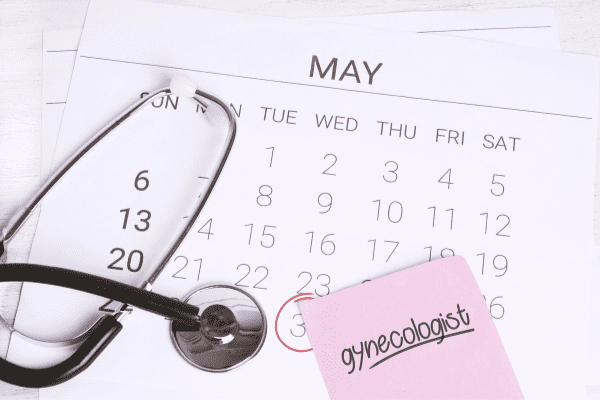This post is sponsored by Olmsted Medical Center

We sat down with Dr. Melissa Richards, chair of Obstetrics and Gynecology at Olmsted Medical Center (OMC), to hear her answers to what she has said is some of the most pressing questions about women’s health in the area of OB/GYN. She tells us that many women are embarrassed to ask questions simply because of the area of the body that’s in question. Below are Dr. Richards’ answers to seven questions that you might be embarrassed to ask your gynecologist.
A sincere THANK YOU to Dr. Richards for sitting down with us to cover these very frequently asked questions. To hear the entire interview with Dr. Richards, watch the video above!
Don’t miss our first post in our series with Dr. Richards: Our Bodies: What’s Normal and What’s Not – Questions for a Gynecologist
Q: Why is pelvic strength important?
Your pelvic floor is like a bowl of muscles on the floor, and core/abdominal muscles are part of this. Women are amazing! After pregnancy, childbirth, age, work, sitting, these muscles start to not work as well, and that can turn into other issues. The importance of improving and maintaining the strength of pelvic floor muscles can prevent a lot of problems and issues down the road.
Q: How can I strengthen my pelvic floor?
This can be a tricky one. Many people talk about kegels, but what I’ve found is that women don’t really know what these muscles are, or how to engage them correctly. By far, the very best way to strengthen the pelvic floor muscles that I most highly recommend– especially after childbirth–is to meet with a Pelvic Floor Physical Therapist. No matter how you gave birth, a human being was in your pelvis for 9 months, and that human being was delivered through your vagina, or else we made an incision through your abdomen and separated those abdominal muscles. Either way, it’s a major stress on those muscles. If this happened to any other body part, of course you’d be sent to physical therapy as part of your recovery! And until this is a routine part of maternal care, I encourage women to advocate for themselves, talk to their provider so we can refer you to a Pelvic Floor Physical Therapist. Pelvic Floor Physical Therapists are typically women, who do a great job explaining what pelvic floor physical therapy is, and get women off to a good start with the best strengthening exercises most appropriate for them and their needs. Then there are follow-up with your provider to make sure that you continue to make progress.
Q: Is it normal that I leak urine?
Quick answer: Yes. Urinary incontinence is very common in women. Over half of women have this issue, and that number goes up to 75% of women by age 75 who will have bladder control/leakage issues. Urinary incontinence usually falls into 2 different categories: 1). Leaking when laughing/coughing/sneezing/jumping. This is called stress incontinence, and is very common. 2). Bladder spasms and urgency, where a person feels like they have to go right now. Most are one or the other, but it is totally possible to have both. One of the things that can often happen is our bladders get trained to create the need to pee frequently. For example, when I was breastfeeding my daughter, I was up most nights at 1am, 3am, and 5am. I would pee every time I was up with her. After a few months, my bladder now was trained to need to pee at 1am, 3am and 5am. So I needed to re-train my bladder. This helped with feeling like I needed to pee all the time.
There are things we can do for both stress incontinence and bladder spasms/urgency. For laugh/cough/sneeze incontinence: Core/pelvic floor physical therapy is great, and can help a lot. Vaginal inserts are a newer option that people don’t know about. It doesn’t fix the problem, but it can help temporarily control the leakage. Surgery is a last option that we don’t approach until a woman is done having babies, but can be effective. For bladder spasms/urgency: I find physical therapy works amazingly. Surgery is an option (after a woman is done having babies), and interestingly, we are now doing a procedure where Botox is injected, and it stops the bladder from spasming.
Q: How often should a woman come in to see you for a pelvic exam?
First, it is important that whatever provider a woman is seeing (GYN, family medicine, internal medicine, etc.), that there is a relationship being built. Yearly well-exams are encouraged, but this does not mean that a woman will need a pelvic exam and a PAP smear every year. We do want to identify issues before they become a problem, but a lot of that is done without needing a physical exam. During a routine well-exam, we would discuss cervical cancer screening, issues with bowel movements, urination, painful periods, pain with sex, pelvic pressure, and other foundational questions. If there are no concerns or issues, then maybe that year we don’t need to do a pelvic exam. Second, what is a pelvic exam? Sometimes it’s as simple as just looking at the vulva and external areas. Other times, it could include a more thorough exam as well as a PAP smear.
Q: When should we come in to see you, outside of our normal yearly well-exam?
If there is something that is interfering with your normal daily life, you need to make an appointment. For example, with periods: if you are unable to work/do your normal daily tasks because of painful periods, or if you’re worrying about accidents, making decisions around your period, or bleeding for longer than a week, it’s a really good time to see your provider. Accidental urination: if it’s a little bit and not bothersome to you, that’s one thing, but if it’s interfering with your daily life, we want you to come in. New onset pain is another reason to make an appointment. Menopause: one thing many women don’t know is that if they are a year past menopause, and suddenly have pink or brown discharge or bleeding like a period, they should definitely be seen. This can be a symptom of uterine cancer. 1 in 10 women will have uterine cancer, and 1 in 10 women will have pre-cancerous cells that can turn into uterine cancer.
Q: I’m getting older. My period is getting heavier. Is this normal?
This is not uncommon, unfortunately. As we get older, our periods can get a little wonky. Some of this can be a structural cause: uterine fibroids (muscle bundles in the uterus–up to 80% women have these, and usually not an issue) occasionally can cause heavier bleeding. Uterine polyps (little things like skin tags in the uterus) can also cause an increase in bleeding. Your thyroid can sometimes cause them to be goofy. And then as we get older, sometimes they just get worse. But we can make it better! We’ll sit down and really talk about it to figure out what is going on, and then laying out what the treatment options are. You don’t have to live in misery with these things!
Q: What discharge is considered normal?
Vaginas are amazing, and have the ability to keep you healthy and safe. Part of this is creating discharge. There is a lot of discharge shaming that happens with women, and that needs to stop. Vaginal discharge changes depending on where a woman is in her menstrual cycle. The amount varies from woman to woman, but for me the marker of something that we need to look at is when there are other symptoms with it. If the discharge is foul or stinky, or if there is itching/burning, new onset pain, or a change after sexual activity with a new partner, we want you to make an appointment to make sure there isn’t any infection causing it. As with so many things, knowing what is normal for your body and being on the lookout for any change is so important.
Want to learn more?
One book that Dr. Richards commonly recommends is a book by Jen Gunter, MD, a triple board certified OB/GYN, as well as Infectious Disease and Pelvic Pain, called The Vagina Bible. She talks about everything we talked about today in plain-spoken way, that is smart and funny, and is a great resource.
Phone: (507) 529-6605

